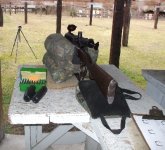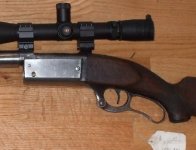You are using an out of date browser. It may not display this or other websites correctly.
You should upgrade or use an alternative browser.
You should upgrade or use an alternative browser.
Type 99 action strength
- Thread starter Roger T
- Start date
MilGunsmith
Member
P.O. Ackley did experiments on blowing up actions with high pressure rounds. The Jap action was one of the strongest. Interesting read. The late war actions were not made as well as the early ones and could be suspect.
jackie schmidt
New member
Here's then Ackley test.
http://dutchman.rebooty.com/temp/Ackley.pdf
Ackley was not vey scientific, but the results are real.
Notice that the Arisaka Actions survived loads that wrecked other military actions.
Based on his test, you could load the Arisaka to 60,000 psi with no ill effects. But keep,in mind, aside from the latest batch of Ultra Mags and custom high capacity chamberings, SAAMI aspects on the vast majority of Factory Loadings are set at 55,000 and below.
What Ackley found out was the actual pressure exerted on the bolt lugs was not the problem in many actions. Ruptured cases did more damage than anything as far as receiver ring failure was concerned. As long as the case stayed intact, it was amazing what just what some actions would take. If the case failed, all bets were off.
If your Type 99 is in good shape, (as in headspace), you can shoot it with any reasonable load using modern brass. Fire some normal loads, and check for case swelling, which would indicate a overly large chamber.
http://dutchman.rebooty.com/temp/Ackley.pdf
Ackley was not vey scientific, but the results are real.
Notice that the Arisaka Actions survived loads that wrecked other military actions.
Based on his test, you could load the Arisaka to 60,000 psi with no ill effects. But keep,in mind, aside from the latest batch of Ultra Mags and custom high capacity chamberings, SAAMI aspects on the vast majority of Factory Loadings are set at 55,000 and below.
What Ackley found out was the actual pressure exerted on the bolt lugs was not the problem in many actions. Ruptured cases did more damage than anything as far as receiver ring failure was concerned. As long as the case stayed intact, it was amazing what just what some actions would take. If the case failed, all bets were off.
If your Type 99 is in good shape, (as in headspace), you can shoot it with any reasonable load using modern brass. Fire some normal loads, and check for case swelling, which would indicate a overly large chamber.
Last edited:
I bought a 1917 Sav 99 250-3000 made in 1917 at a gunshow for $175 in 2004. The barrel is shot out.
I re threaded a 6mmPPC benchrest take off barrel and chambered for 6mmBR.
I worked up until CCI 450 small rifle magnum primers would pierce.
I drilled and tapped for a scope. I took it to the range and shot about 6 groups. The best were: 0.1" 3 shot group at 50 yards, 0.3" 3 shot group at 100 yards.
0.1" 3 shot group at 50 yards, 0.3" 3 shot group at 100 yards.
The ratio between proof loads and working loads is approximately the ratio for steel between plastic deformation and fatigue at 10,000 cycles. This is about 1.3
The pressure that a primer will pierce depends on the thickness of the cup, the firing pin to firing pin hole fit, the firing pin shape, and the firing pin mass.
A better approximation is Quickload when the velocity prediction matches the chrono results.
That Sav 99 at loads a safety margin below primer piercing will stretch 6mmBR brass ~ 0.003".
This is at a higher pressure than a Lee Enfield will stretch brass 0.003", but it is still not good.

I re threaded a 6mmPPC benchrest take off barrel and chambered for 6mmBR.
I worked up until CCI 450 small rifle magnum primers would pierce.
I drilled and tapped for a scope. I took it to the range and shot about 6 groups. The best were:
 0.1" 3 shot group at 50 yards, 0.3" 3 shot group at 100 yards.
0.1" 3 shot group at 50 yards, 0.3" 3 shot group at 100 yards.The ratio between proof loads and working loads is approximately the ratio for steel between plastic deformation and fatigue at 10,000 cycles. This is about 1.3
The pressure that a primer will pierce depends on the thickness of the cup, the firing pin to firing pin hole fit, the firing pin shape, and the firing pin mass.
A better approximation is Quickload when the velocity prediction matches the chrono results.
That Sav 99 at loads a safety margin below primer piercing will stretch 6mmBR brass ~ 0.003".
This is at a higher pressure than a Lee Enfield will stretch brass 0.003", but it is still not good.


